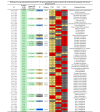Functional modulation of the human gut microbiome by bacteria vehicled by cheese
- PMID: 40019271
- PMCID: PMC11921328
- DOI: 10.1128/aem.00180-25
Functional modulation of the human gut microbiome by bacteria vehicled by cheese
Abstract
Since cheese is one of the most commonly and globally consumed fermented foods, scientific investigations in recent decades have focused on determining the impact of this dairy product on human health and well-being. However, the modulatory effect exerted by the autochthonous cheese microbial community on the taxonomic composition and associated functional potential of the gut microbiota of human is still far from being fully dissected or understood. Here, through the use of an in vitro human gut-simulating cultivation model in combination with multi-omics approaches, we have shown that minor rather than dominant bacterial players of the cheese microbiota are responsible for gut microbiota modulation of cheese consumers. These include taxa from the genera Enterococcus, Bacillus, Clostridium, and Hafnia. Indeed, they contribute to expand the functional potential of the intestinal microbial ecosystem by introducing genes responsible for the production of metabolites with relevant biological activity, including genes involved in the synthesis of vitamins, short-chain fatty acids, and amino acids. Furthermore, tracing of cheese microbiota-associated bacterial strains in fecal samples from cheese consumers provided evidence of horizontal transmission events, enabling the detection of particular bacterial strains transferred from cheese to humans. Moreover, transcriptomic and metabolomic analyses of a horizontally transmitted (cheese-to-consumer) bacterial strain, i.e., Hafnia paralvei T10, cultivated in a human gut environment-simulating medium, confirmed the concept that cheese-derived bacteria may expand the functional arsenal of the consumer's gut microbiota. This highlights the functional and biologically relevant contributions of food microbes acquired through cheese consumption on the human health.IMPORTANCEDiet is universally recognized as the primary factor influencing and modulating the human intestinal microbiota both taxonomically and functionally. In this context, cheese, being a fermented food with its own microbiota, serves not only as a source of nourishment for humans, but also as a source of nutrients for the consumer's gut microbiota. Additionally, it may act as a vehicle for autochthonous food-associated microorganisms which undergo transfer from cheese to the consumer, potentially influencing host gut health. The current study highlights not only that cheese microbiota-associated bacteria can be traced in the human gut microbiota, but also that they may expand the functional repertoire of the human gut microbiota, with potentially significant implications for human health.
Keywords: food; human diet; metabolomics; metagenomics; metatranscriptomics; microbiota.
Conflict of interest statement
The authors declare no conflict of interest.
Figures




References
MeSH terms
Grants and funding
LinkOut - more resources
Full Text Sources
Research Materials

